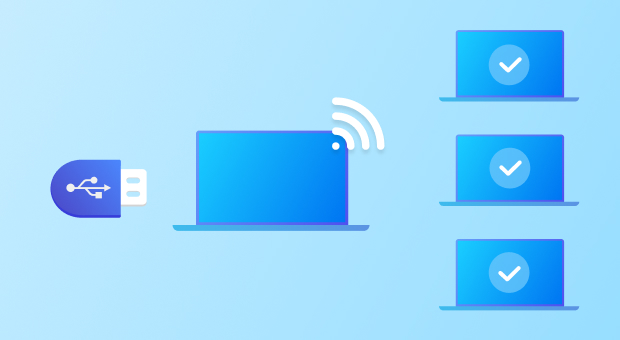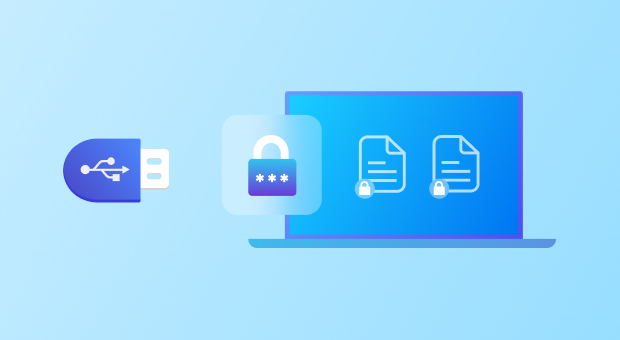Electronic Team uses cookies to personalize your experience on our website. By continuing to use this site, you agree to our cookie policy. Click here to learn more.
What is a dongle for a computer? A USB dongle is any device that acts as a functional extension of the host computer, and doesn’t have any functionality or interactivity on its own. For instance, a flash drive would qualify, but a USB-connectible phone or a keyboard wouldn’t.
Dongles are generally divided into 3 different types: storage dongles, adapters, and key dongles. They can fulfill various roles, including multi-factor authentication. In this article, you can learn about all 3 of them, including some additional information on how to share a security dongle on a network.
Table of Contents
The USB connector of a dongle is usually its biggest physical component. In reality, all the processing and storage occurs on a small chip hidden in the plastic casing. When powered, the chip attempts to interface with the computer - and, if it’s compatible, succeeds.
In some cases, instead of the operating system itself, a dongle requires an additional layer of drivers to interpret its output. However, due to standardization being in the interest of most vendors, the vast majority of dongles are compatible with all popular operating systems and require no drivers, which has come to be referred to as “plug-and-play”.
While it would be nice to have every computer component use the USB interface, its limited throughput compared to PCI Express, SATA, and other connectors limits its applications. Overall, USB dongles have found their niche in storage, adapters, and physical software protection keys.

Adapter dongles can be divided into network and hardware adapters. Network dongles thrive in low-bandwidth applications, such as Bluetooth, or situations where portability matters, since potential WiFi bandwidth is much higher than that of a USB connection. Hardware adapters include device or brand-specific wireless connectors, or adapters for SD and Micro SD cards.
A set of adapter dongles can make any PC compatible with a range of networks and hardware types, but they can pose a problem on systems that lack driver support, or during an OS installation process, before the drivers have been initiated.
Most commonly, these comprise Bluetooth and WiFi adapters, but also include some edge cases, such as radio communication systems. WiFi USB adapters in particular are highly vulnerable to interference, and become clunky when an antenna is added to them, to no great effect.
Another thing to keep in mind is the device limit for Bluetooth dongles, due to the abundance of modern devices that connect directly via Bluetooth - game controllers, audio devices, and others.
SD and Micro SD adapters are almost exclusively used to access these cards on desktop PCs. Unplugging a card from a device - whether a phone or a camera - and using a USB adapter to transfer files is commonly faster than connecting to the device over USB.
Often, instead of using generic Bluetooth, hardware companies lock their wireless mice and keyboards to a specific adapter type. These have benefits and drawbacks, but the main downside is using up one more USB slot and rendering the hardware useless if the dongle is lost.

A USB dongle can be embedded with an authorization key. These keys can either be used to verify your identity on various platforms, unlock a digital keychain, or provide a digital license to use apps, such as CAD software. The software authorization dongles are also known as HASP (hardware against software piracy) keys.
A physical USB key is a good method of two-factor authentication, both because they create an unhackable air gap, and also due to the risks of phone authenticators - mainly to do with the fact that phones are easy to compromise. USB authentication dongles commonly use two keys - a public key and a private key, which means that they can be used without the fear that the data on the device is copied and compromised.
USB storage dongles fill two important niches - handy storage and transfer for low volumes of files, and OS recovery and installation. While the former is more widely known, the latter is no less important. Currently, an external USB volume is the only way, other than a CD, for an average user to create recovery media. A recovery dongle is a good way to ensure that you can save your files even in the event of system failure, so it’s best to have one both for Windows and for Linux. In addition, it means that you can recover an operating system on a PC without a CD tray, or in the case of a CD drive failure.
Do you want to get authorized in apps and websites over RDP, in virtual machines, or simply on a remote computer? Donglify makes accessing software security Dongles remotely over a network as easy as a single click. Use your own dongles from anywhere, or grant temporary access to your coworkers with easily rescindable tokens.
With Donglify, a single device can be shared simultaneously to multiple computers. It’s available on Windows 10 and 11, Windows Server, Windows on ARM, and macOS, with full cross-platform compatibility. The 2048-bit SSL encrypted connection will ensure that no one can intercept your authentication data. Save on USB ports and turn your physical dongles digital with Donglify!